One small mistake in a critical process can lead to costly downtime, security risks, or even complete system failures. That’s why organizations rely on a well-structured Method of Procedure (MOP). It’s a step-by-step blueprint that makes sure every task is executed flawlessly.
Table of Contents
Whether you’re launching a product, managing a data center, or setting up a complex system, an MOP ensures that every step is planned, executed, and documented properly. But what exactly is an MOP, and why is it essential? Let’s break it down.
What is a Method of Procedure?
A Method of Procedure (MOP) is a structured document that outlines a step-by-step guideline for performing a specific task. It’s designed to eliminate guesswork and reduce human error by ensuring that every action follows a pre-approved plan. Think of it as a standard operating procedure (SOP) tailored to critical operations where precision is key.
MOPs are widely used in data center management, IT, telecommunications, construction, and healthcare industries. They help organizations reduce risk, ensure consistency, and perform tasks efficiently. A well-documented MOP also helps with version control, making sure updates and changes are properly tracked.
How Product Teams Can Benefit from a Method of Procedure
A product team can use a Method of Procedure at different stages of product development. It ensures clarity, accountability, and efficiency in processes. Here’s how:
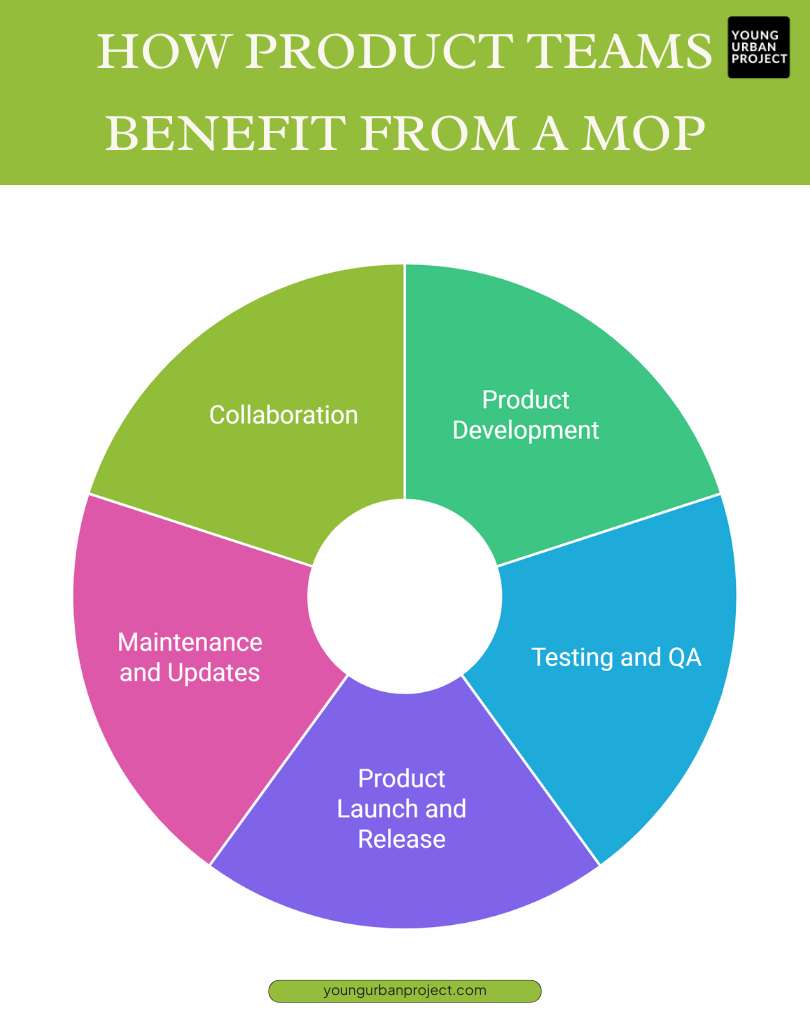
1. Product Development
During product development, a Method of Procedure provides clear guidelines for each stage, from ideation to execution. It helps the team align with the product roadmap and ensures that all necessary steps are taken before moving forward. Having a step-by-step guide eliminates confusion and allows teams to focus on innovation without guesswork.
2. Testing and QA
A well-documented MOP is crucial during testing and quality assurance (QA). It includes step-by-step instructions to identify potential bugs, conduct performance tests, and ensure that the product meets quality standards. By following a structured approach, teams can reduce human error and maintain consistency across different testing phases.

3. Product Launch and Release
Launching a product without a solid MOP is like flying blind. A Method of Procedure outlines the safety precautions, prerequisites, and necessary checks before launching a product. It ensures that all stakeholders are aligned and that every phase, from pre-launch to post-launch support, is executed smoothly.
4. Maintenance and Updates
Products require continuous improvements and updates. An MOP helps in version control by documenting changes systematically. It ensures that teams follow a standard operating process while updating features, fixing bugs, and maintaining security protocols.
5. Collaboration
A well-structured Method of Procedure promotes better collaboration among team members. It helps different departments work together efficiently by providing clear step-by-step communication, problem-solving, and decision-making guidelines. By reducing guesswork, a Method of Procedure ensures that all stakeholders are on the same page.
Also read: Understanding the New Product Development Process
Why Use a Method of Procedure?
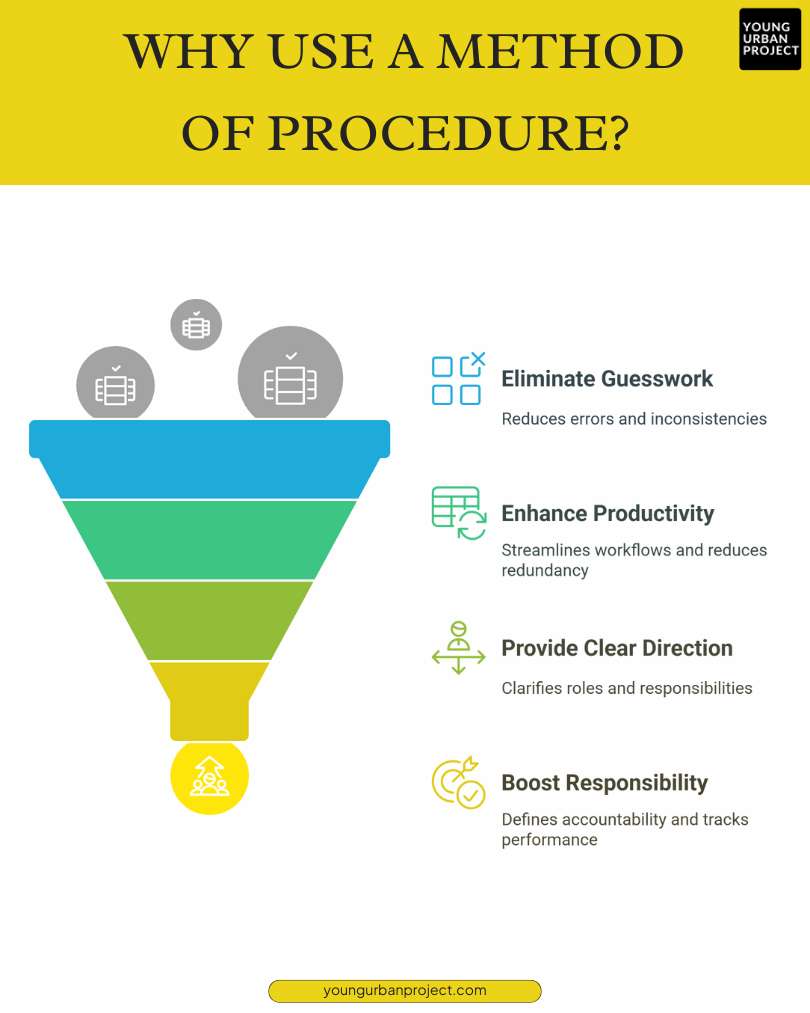
1. Eliminates Guesswork
A MOP provides a structured, step-by-step approach to completing tasks, ensuring employees don’t have to rely on memory or assumptions. This reduces errors, increases consistency, and improves efficiency. Team members may perform tasks differently without a defined procedure, leading to inefficiencies and potential risks. A well-documented method of procedure ensures that every task is executed the right way.
2. Enhances productivity
Following a Method of Procedure helps teams eliminate redundant steps and focus only on the necessary actions, reducing time wasted on trial-and-error approaches. By streamlining workflows, organizations can achieve faster execution, maintain quality control, and minimize downtime. A structured process also enables employees to complete tasks with confidence, knowing they are following a proven method for success.
3. Offers clear direction
A MOP provides clear and concise instructions, ensuring every team member understands their role and responsibilities. Ambiguity in operations can lead to confusion, errors, and inefficiencies. A well-structured Method of Procedure eliminates misinterpretation, making it easier for employees to perform their tasks correctly. This clarity fosters better communication and collaboration across departments, ensuring seamless execution.
4. Boosts responsibility
By clearly defining roles, responsibilities, and expected outcomes, a MOP holds individuals accountable for their contributions. It helps managers track performance and ensure tasks are completed as planned. A well-documented procedure fosters a culture of responsibility, making it easier to identify bottlenecks, measure progress, and improve overall team efficiency.
How to Develop an Effective MOP
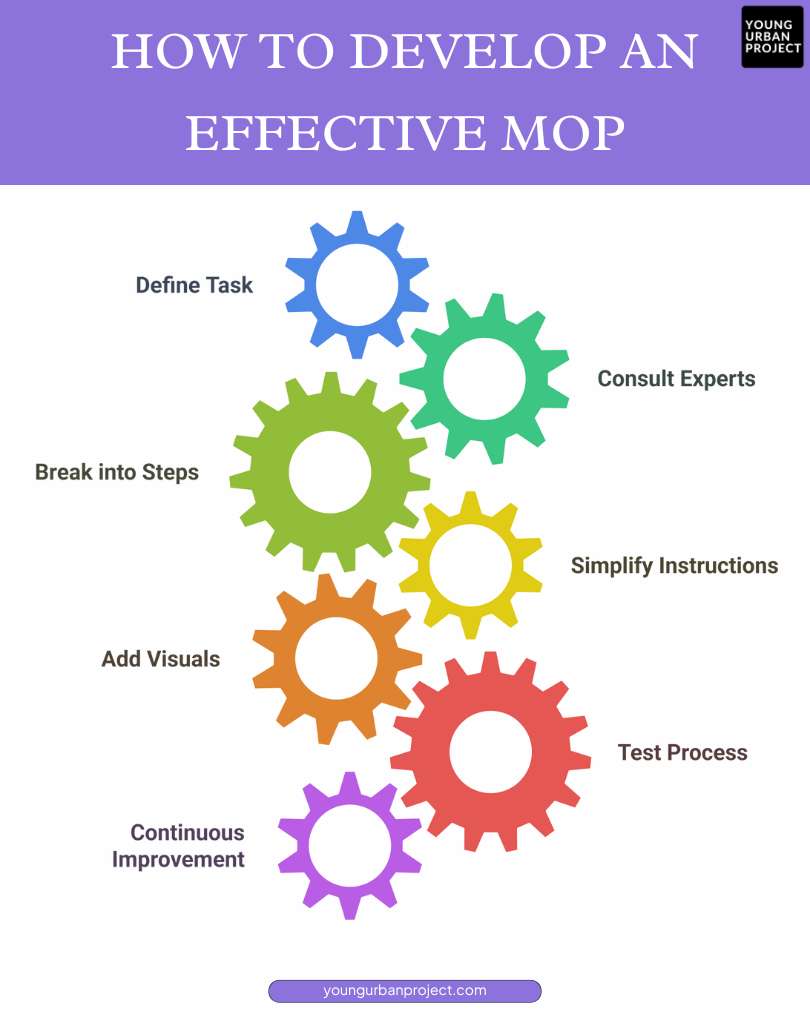
1. Define the Task Clearly
Start by clearly stating what the task is. Whether it’s setting up software, fixing a data center, or installing equipment, knowing the goal makes the process useful and effective. This also helps determine the steps, tools, and people needed to do the job correctly.
2. Ask Experts for Help
Talk to people who have done the task before. Their experience makes sure the process is practical, works well, and follows industry rules. They can also point out problems and share tips to avoid mistakes.
3. Break It into Small Steps
Split big tasks into smaller, easy-to-follow steps. Each step should be simple and clear to avoid mistakes. This makes it easier for everyone, even new people, to follow the process and do it the same way every time.
4. Keep It Simple and Clear
Use plain, easy-to-understand language. Avoid hard words that might confuse people. Make the instructions straightforward and format them so they’re easy to read. This helps people follow the steps without getting stuck or making errors.
5. Add Pictures or Diagrams
Use visuals like flowcharts, drawings, or labeled images to explain tricky parts. These make the steps easier to understand and reduce mistakes. A well-illustrated guide keeps people focused and helps them follow the steps correctly.
6. Test the Process First
Try out the process with a small group before using it everywhere. This helps find any problems, gaps, or areas to improve. Feedback from this test makes the process better, easier to use, and more effective in real situations.
7. Keep Improving Over Time
Regularly update the process based on feedback, results, and changes in the industry. This keeps it useful and matches the needs of the business. Regular check-ups also help find and fix any issues to improve the process.
Also read: 10 Creative Product Launch Ideas
What Should a Method of Procedure Include?
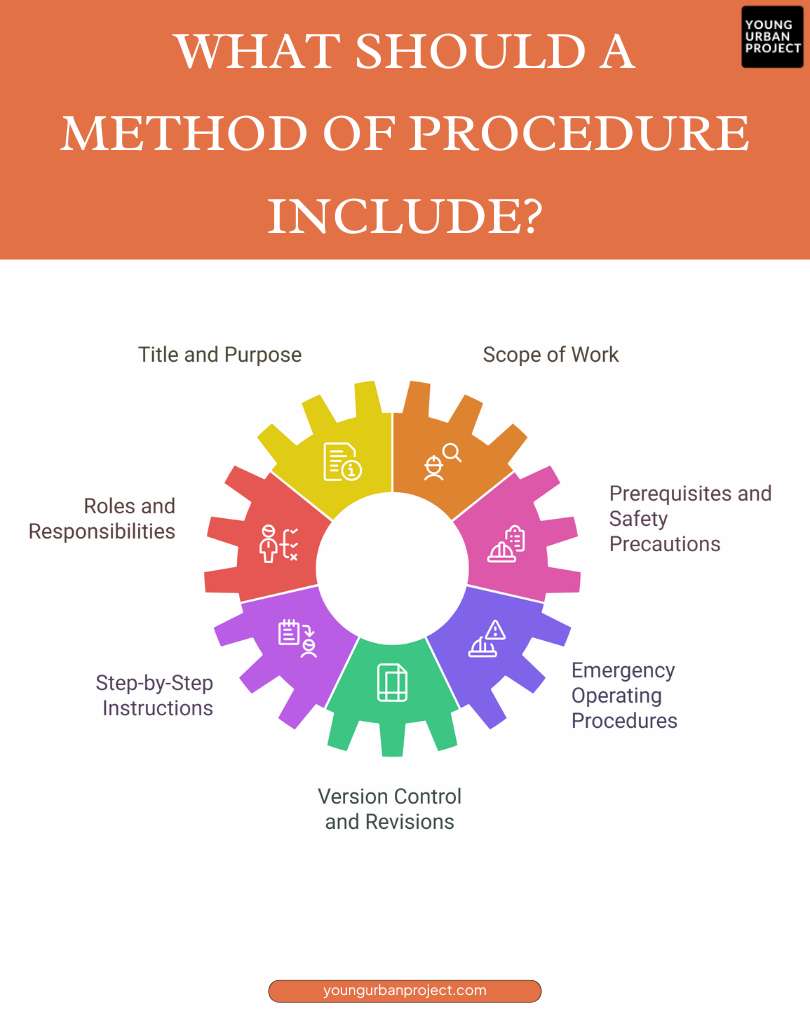
1. Title and Purpose
The Method of Procedure should start with a clear title and a short explanation of its goal. This helps users quickly know what the document is about and why it’s important. The purpose should explain why the procedure is needed, its aims, and how it helps with efficiency, safety, or rules. A clear title and purpose make sure the MOP is used correctly.
2. Scope of Work
This part explains what the procedure covers and what it doesn’t. It lists the tasks, systems, and any limits. A clear scope avoids confusion, so employees focus only on the right steps. It also helps decide if other procedures or documents are needed for tasks outside this scope.
3. Roles and Responsibilities
This section clearly states who is in charge of each step. It assigns tasks to team members, managers, or operators. Listing responsibilities reduces confusion, avoids repeating work, and ensures every part of the procedure is handled by the right person.
4. Prerequisites and Safety Precautions
This part explains what’s needed before starting the procedure. It includes tools, approvals, conditions, and safety gear. Safety steps are important to prevent accidents and follow the rules. Listing risks and how to handle them early creates a safe and smooth work environment.
5. Step-by-Step Instructions
This is the main part of the MOP. It gives clear, step-by-step directions to complete the task. Each step should be simple and easy to follow, with technical words only if needed. Using numbers or bullet points makes it easier to read. Including what to expect after each step helps users check progress and spot mistakes early.
6. Emergency Operating Procedures
This section explains what to do if something goes wrong during the procedure. It includes fixing problems, stopping work safely, and who to contact for help. Having a plan ensures issues are handled quickly, reducing delays and preventing bigger problems.
7. Version Control and Revisions
The method of procedure should have a record of updates to ensure that users follow the latest version. This part lists revision dates, changes made, and who made them. Keeping the document updated ensures it improves over time, follows new best practices, and avoids using old or wrong procedures.
MOP Use Cases in Different Industries
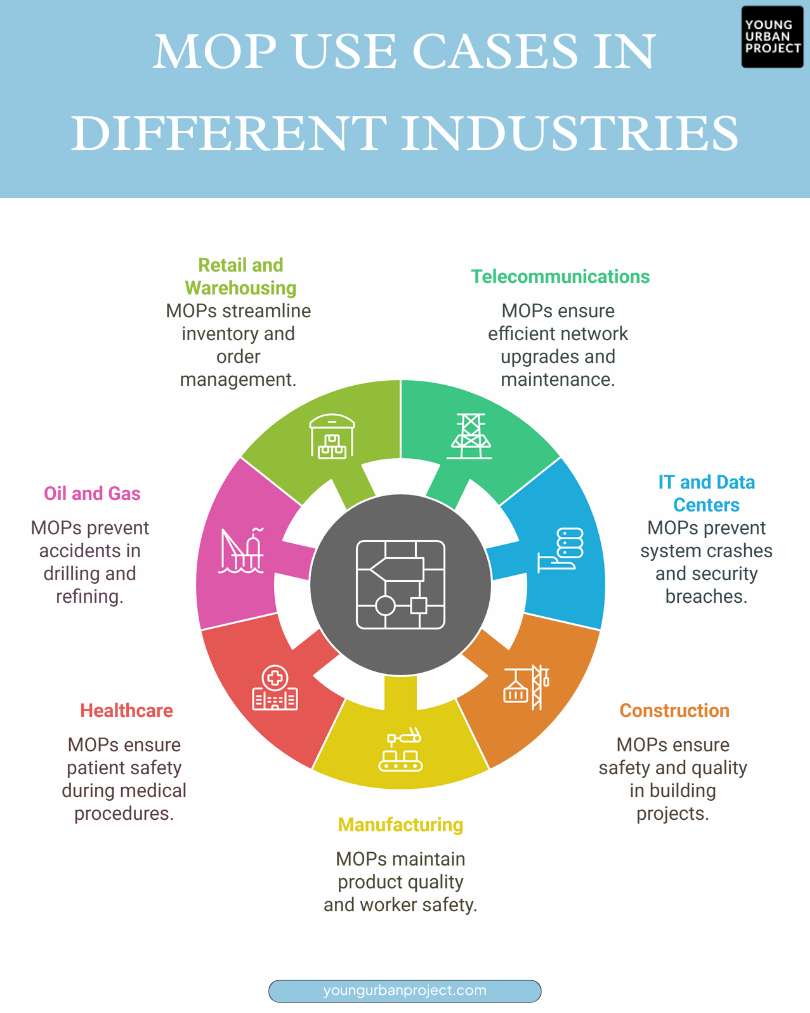
1. Telecommunications
In telecom, MOPs help install fiber-optic cables, set up mobile towers, or upgrade network equipment. They provide clear steps to avoid errors and minimize downtime. For example, when a company installs 5G towers, a method of procedure ensures that every step—from site preparation to testing—follows a set process, preventing network failures and ensuring smooth service.
2. IT and Data Centers
IT teams use MOPs for tasks like software updates, cybersecurity checks, and server replacements. Mistakes can lead to system crashes or security breaches without a proper procedure. For example, when a company upgrades cloud servers, an MOP ensures backups are taken, downtime is minimized, and all configurations are correctly applied, keeping business operations running smoothly.
3. Construction
MOPs help teams build roads, bridges, and buildings safely by following step-by-step guidelines. They reduce risks and ensure quality. For example, when constructing a high-rise building, a Method of Procedure outlines safety checks, material inspections, and installation steps for plumbing and electricity, preventing costly mistakes and ensuring worker safety.
4. Manufacturing
Factories use MOPs to maintain product quality and worker safety. These procedures guide workers in machine operation, assembly-line tasks, and quality control checks. For example, an automobile company follows an MOP to ensure each car part is assembled correctly, preventing defects and reducing recalls. This leads to safer vehicles and satisfied customers.
5. Healthcare
Hospitals and clinics use MOPs to ensure patient safety during surgeries, treatments, and emergency procedures. They help doctors, nurses, and staff follow the correct steps for medical procedures. For example, during heart surgery, a Method of Procedure ensures that all surgical instruments are properly sterilized, patient vitals are monitored, and recovery steps are followed to reduce risks.
6. Oil and Gas Industry
MOPs help workers handle equipment safely and prevent accidents in refineries and drilling sites. For example, when starting an oil rig, an MOP ensures safety gear is worn, pressure levels are checked, and emergency plans are in place, reducing the risk of explosions or oil spills.
7. Retail and Warehousing
MOPs help manage inventory, restock shelves, and handle customer orders efficiently. For example, an e-commerce warehouse follows a Method of Procedure to process and ship orders, ensuring items are packed correctly, shipping labels are accurate, and deliveries reach customers on time without errors.
Also read: Product Lifecycle Management
Method of Procedure Examples
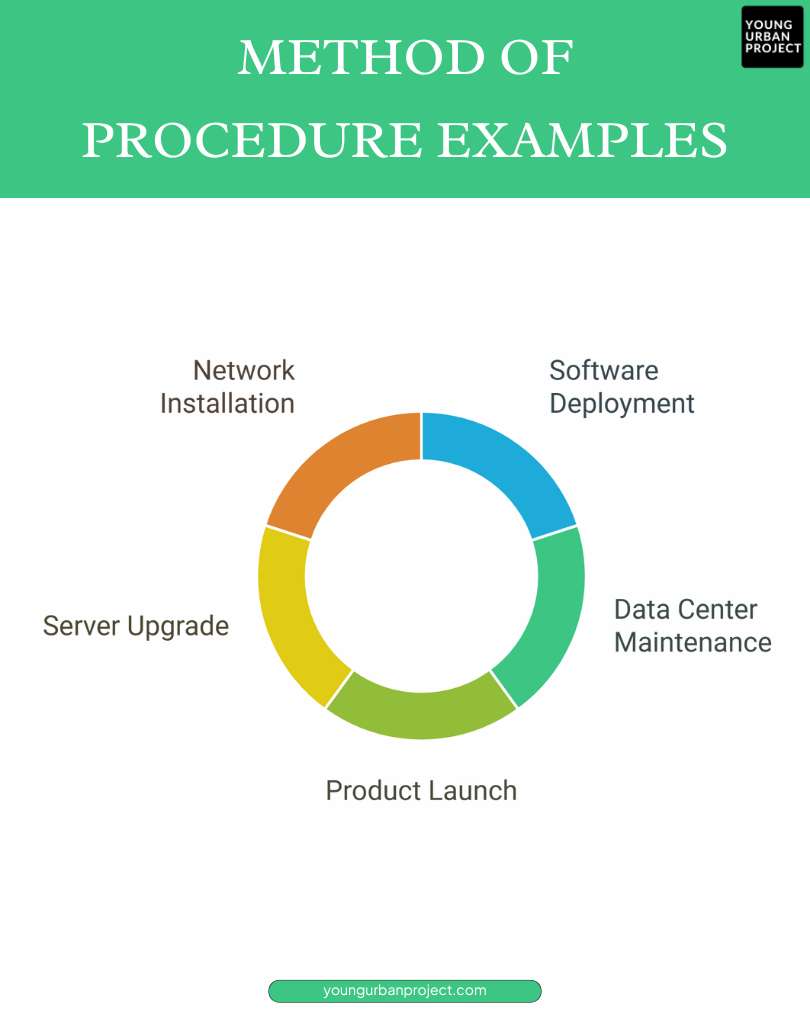
1. Software Deployment MOP
When a company updates its software, a Method of Procedure ensures everything runs smoothly. It includes steps like testing the new version, backing up old data, and installing updates carefully. For example, when a bank upgrades its online banking system, a Method of Procedure ensures there are no errors, customers don’t lose access, and all transactions remain safe.
2. Data Center Maintenance MOP
Data centers store important business information, so maintenance must be done carefully. A MOP guides teams on cleaning servers, updating security systems, and checking power backups. For example, during routine maintenance, a Method of Procedure ensures that no data is lost, systems stay online, and issues like overheating are fixed before they cause serious damage.
3. Product Launch MOP
Before launching a new product, businesses follow a Method of Procedure to ensure everything is ready. This includes final testing, marketing activities, and supply chain checks. For example, when a smartphone company releases a new model, an MOP ensures stores have enough stock, advertisements are running, and all customer support teams are prepared for questions.
4. Server Upgrade MOP
Upgrading a server can be risky if not done properly. A Method of Procedure helps IT teams move data, install new hardware, and test performance without causing downtime. For example, when an online shopping website upgrades its servers before a big sale, an MOP ensures the website stays fast, secure, and available to customers.
5. Network Installation MOP
Setting up a new internet network requires careful planning. A MOP helps technicians lay cables, configure routers, and test connections. For example, when a university installs Wi-Fi across its campus, a Method of Procedure ensures strong signals in all buildings, prevents network failures, and makes sure students can connect without problems.
Bottom Line
A Method of Procedure (MOP) is like a step-by-step guide that helps teams get things done right every time. Whether you’re launching a product, managing a data center, or handling emergencies, an MOP makes sure everyone knows what to do and how to do it. It cuts out the guesswork, saves time, and reduces mistakes. For product teams, a MOP is a game-changer. It helps with everything from development and testing to launches and updates. It keeps the team on track, improves teamwork, and ensures tasks are done safely and efficiently.
In industries like telecom, IT, healthcare, and manufacturing, MOPs are essential for smooth operations. They provide clear instructions, reduce risks, and make sure everyone is on the same page. By using a MOP, teams can work smarter, not harder. It’s a simple tool that brings big results, making complex tasks easier and more manageable. So, if you want to boost productivity and avoid errors, an MOP is the way to go!
FAQs: Method of Procedure
1. What’s the difference between a MOP and an SOP?
A MOP (Method of Procedure) is a detailed, step-by-step guide for a specific task, like setting up a server or launching a product. It’s very focused and task-specific. On the other hand, an SOP (Standard Operating Procedure) is broader and covers recurring processes or general workflows, like how to handle customer complaints. While a MOP is about “how to do this one thing,” an SOP is about “how we do things here.”
2. Why is version control important in a MOP?
Version control ensures that everyone is using the most up-to-date version of the MOP. Without it, team members might follow outdated steps, leading to mistakes or inefficiencies. By tracking changes and updates, version control keeps the MOP accurate and relevant, especially when processes evolve or new tools are introduced. This helps maintain consistency and reduces the risk of errors caused by following old instructions.
3. Can a MOP reduce human error?
Yes, a MOP reduces human error by providing clear, step-by-step instructions. When tasks are complex or involve many steps, it’s easy to miss something or make mistakes. A MOP acts as a checklist, ensuring every step is followed correctly. This is especially helpful in high-stakes situations, like data center management or healthcare, where even small errors can have big consequences.
4. How often should a MOP be updated?
A MOP should be reviewed and updated regularly, especially when there are changes in processes, tools, or team roles. For example, if new software is introduced or safety regulations change, the MOP needs to reflect those updates. Regular reviews, like quarterly or annually, ensure the MOP stays accurate and effective. This keeps the team aligned and reduces the risk of following outdated procedures.
5. Who should create a MOP?
A MOP should be created by experts who know the task inside and out. This could be senior team members, engineers, or specialists. It’s also important to involve stakeholders and other team members who will use the MOP. Their input ensures the MOP is practical, clear, and covers all necessary steps. Collaboration during creation helps make the MOP more effective and easier to follow.
6. Can a MOP be used in emergencies?
Yes, a MOP can be used in emergencies. In fact, an emergency operating procedure is a type of MOP designed specifically for critical situations. It provides step-by-step instructions for handling emergencies, like power outages, data breaches, or equipment failures. A well-prepared MOP ensures the team acts quickly and correctly, minimizing damage and keeping everyone safe during high-pressure situations.
7. What’s the best way to ensure a MOP is followed?
To ensure a MOP is followed, train team members on how to use it and explain why it’s important. Make the MOP easily accessible, like in a shared folder or printed manual. Regularly remind the team to refer to it, especially for complex tasks. Emphasize how the MOP ensures consistency, safety, and efficiency. When everyone understands its value, they’re more likely to follow it.

